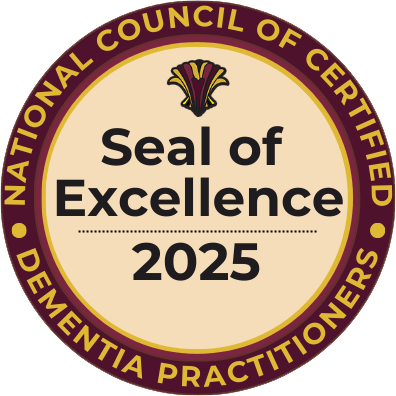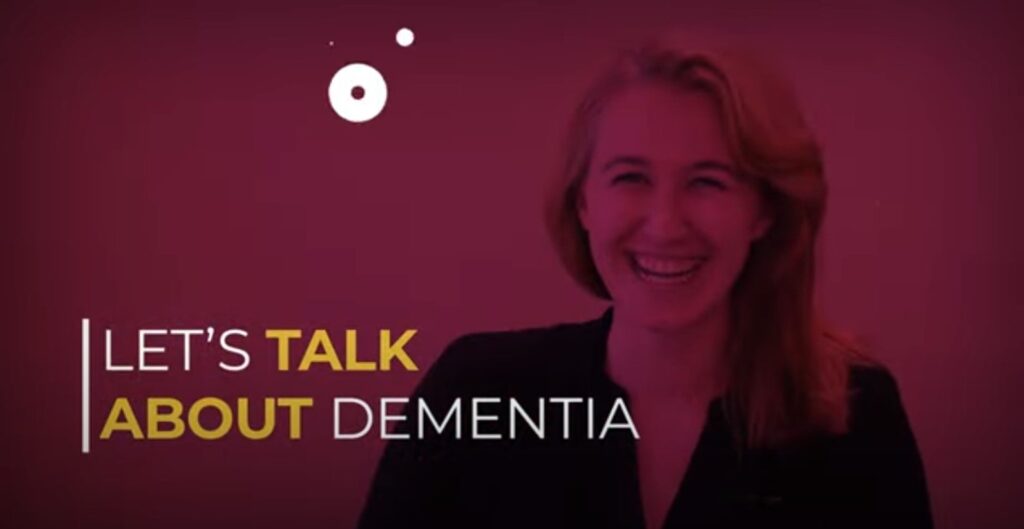Transcript:
Hi, everyone and welcome back. I’m Lynne Biot Gordon, the co-founder of the National and International Council of Certified Dementia Practitioners. Welcome back to our series, Let’s Talk About Dementia! So today, we’re going to be talking about Frontotemporal Dementia and what is that? Well, Frontotemporal Dementia describes exactly the parts of the brain that it affects. It is related to a group of disorders that gradually affect both the temporal lobe and the frontal lobe of the brain and what we’ll start to see is changes in behavior, emotion, communication, and movement.
Now, of all of the diseases that cause dementia, Frontotemporal Dementia is actually a rare one and we usually see it occurring in patients of a younger age group, usually those between the ages of 45 and 64 years of age. So we’re looking at a very serious case that affects younger people. The various behavioral expressions that may change so some of the Expressions you might see in your patient. Behaviorally, you might see now that they are easy to anger, that they might speak out of turn, or say things that are inappropriate. You might see more interest in sex, more outbursts, maybe swearing. There’s a variety of behavioral expressions and emotional expressions that we might see because of the changes happening in the brain because of the effects of the frontal lobe as well as the temporal lobe.
So, let’s talk about what the presentations are when someone is suffering with Frontotemporal Dementia. Some of the symptoms that you’re going to see will be decreased energy and fatigue, lack of motivation, maybe lack of interest in others, or a lack of interest in former hobbies or pursuits. You might start to see inappropriate and impulsive behaviors and that’s what I was speaking to, referring to earlier, when I said you’ll see behavioral or emotional changes. So you might start to see inappropriate or impulsive reactions to things, maybe even not even acting considerate of others or bursting into the middle of a conversation at the inappropriate time and with inappropriate affect or inappropriate emotion. Repeating an activity or repeating a word over and over again. Also changes in food preferences. You start to see sometimes compulsive eating as well. So even though they’ve just completed a meal they’ll say they’re still hungry and they’ll keep eating and then they’ll go back to a cabinet and start eating again so you might see some of those compulsive eating behaviors. You might see increased interest in sex and intimacy. You might start to see also a neglect of personal hygiene so now if they’ve usually been clean shaven, now you might see that it’s a little off. So maybe part of the beard is here and the other side is clean shaven so you look for signs of just deterioration in their ability to manage their personal hygiene. Difficulty understanding speech, difficulty with their own words. They’ll start to see maybe a decrease in their ability to read or write. In terms of movements, you might start to see problems with balance and walking so you might start to see an increase in trips and falls even if there was nothing in their walkway. You might see them just fall and that’s a part of the movement disorder that might start to present itself. You might start to see restricted eye movements as well so that they’ll start to maybe turn their head left and right rather than actually moving their eyes from left to right. You also might start to see shaky hands or Tremors and you might start to see muscle weakness and loss of you know fine motor skills so those are some of the presentations or symptoms that we should be on the lookout for when someone suffers with Frontotemporal Dementia.
So, we just talked about what the presentations are for Frontotemporal Dementia but now let’s talk about the treatments. This is a difficult disease, like most neurocognitive disorders. Because they are progressive, there is no cure. There is no prevention and there’s no way to reverse the damages once they start to run their course, but one of the things that we can do in terms of treatment is considering first behavioral treatments. If the person that you’re taking care of has tremendous behavioral issues or emotional problems now because of the disease, you might want to sit with the physician and talk about maybe psychotropic medication or maybe antidepressants and of course the clinician will make that decision on what’s most appropriate for your loved one or your client. Then the other form of treatment that you want to think about, especially if someone is suffering from movement disorders, is it might be recommended that they’d be in physical therapy or occupational therapy. Those are always considerations especially for someone who’s starting to have disturbances. Considering speech issues over time your client or your loved one might start to have difficulty understanding your words and so it’s important to speak very distinctly and clearly at a tone that the person can hear. A level of volume that they can hear clearly and not speak too fast. To present one item or one idea at a time so rather than saying “oh, Harold look, your wife just did the laundry, do you want the blue shirt the red shirt or the green shirt?” We slow down and we give them choices and say “Harold, would you like the blue shirt or maybe the green shirt?” So, you go slower and you still give them your choices to make their own decisions. So, that’s just one trick that we use. Let’s call it in terms of interventions for communication. Especially once our loved one or our client is starting to have issues with understanding the spoken word.
In all cases, remember what’s most important in any issue or any expression from our client, whether it’s behavioral, whether it’s mood or affect or speech issue, it’s important for us to bring understanding and patience to every circumstance. To give that person time to express themselves, whether it’s negative or positive, give them time to express themselves, be very patient and also remember that they themselves realize in a lot of cases that they’re not presenting themselves the way that they normally would. So they’re going to need encouragement and validation from you as well and moving forward one of the things that you should do also especially with someone recently diagnosed with Frontotemporal Dementia is to sit with the physician and family and talk about a future plan. To plan out future care, future financial decisions that might need to be made, as well as specifically advanced directives on you know, and giving your client or your loved one the choice way in advance to tell them tell you what their medical decisions would be or what their choices are while they can still convey that to us. So that’s important when we talk about any of the neurocognitive disorders but especially one that is running very progressively. For, in this case, a rare group where usually younger folks are not really thinking about planning ahead whereas this illness affects the brain, unfortunately, at younger ages. So it’s time for us to start planning as though we were a little older.
So, that’s one thing to consider. It’s very important to think about the future, because of the progression of this illness. So, I hope today’s information about Frontotemporal Dementia has been useful for you. And remember, for more information it’s important to sit down with your physician to get all the details about your loved one’s illness as well as other resources that might be of support to you. So, thank you again for tuning in for today’s session of Let’s Talk About Dementia. See you next time!























